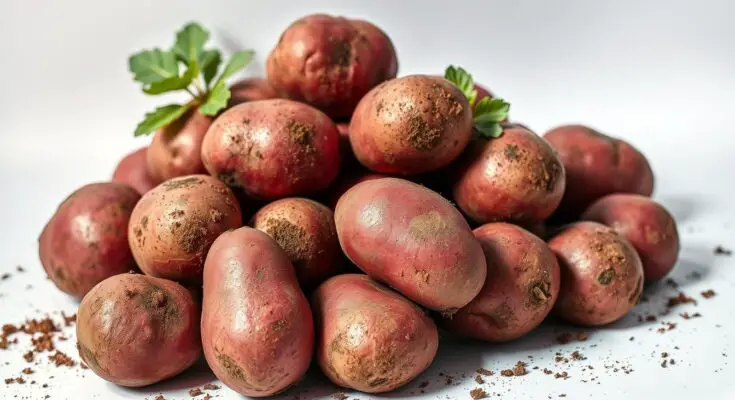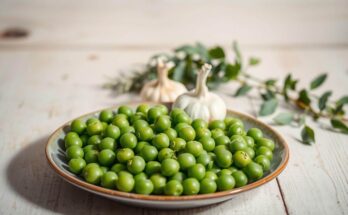Wondering if red potatoes are Paleo? Discover whether they fit the Paleo diet, their nutritional benefits, and expert-approved alternatives. Learn the rules and exceptions!”
The paleo diet has gained popularity for its promise of a return to our ancestral eating habits, but it leaves many wondering about the place of certain foods, like potatoes, in this modern interpretation.

The debate surrounding potatoes, particularly red potatoes, and their compatibility with the paleo diet is ongoing. While some argue that potatoes are too starchy, others see them as a valuable source of nutrients.
As we explore the nuances of the paleo diet and its stance on red potatoes, it becomes clear that understanding the diet’s core principles is essential to resolving this debate.
Understanding the Paleo Diet Principles
Understanding the principles of the Paleo diet is essential for determining which foods are acceptable and which are not. The Paleo diet is more than just a dietary choice; it’s a nutritional approach that seeks to align modern eating habits with the presumed dietary patterns of our ancestors during the Paleolithic era.

The Stone Age Eating Philosophy
The Paleo diet is rooted in the idea that our bodies are genetically adapted to the diet of our Paleolithic ancestors, which consisted mainly of meats, fish, fruits, vegetables, nuts, and seeds. Proponents argue that this way of eating can lead to improved health and reduced risk of chronic diseases.
Foods Encouraged on the Paleo Diet
On the Paleo diet, foods that are encouraged include lean meats, fish and seafood, fresh fruits and vegetables, eggs, nuts, and seeds. These foods are chosen because they are considered to be similar to the foods that would have been available to our ancestors during the Paleolithic era.
Foods Typically Excluded
The Paleo diet excludes foods that became more common with the advent of farming and processing, such as dairy products, grains, legumes, added sugars, and processed foods. The exclusion of these foods is based on the premise that they are not aligned with our genetic makeup and can lead to health issues.
By understanding which foods are encouraged and excluded, individuals can make informed decisions about their dietary choices.
The Controversial Status of Potatoes in the Paleo Diet
As a diet that focuses on foods available during the Paleolithic era, the Paleo diet’s stance on potatoes is inherently controversial. Potatoes, being a staple food in many modern diets, were not consumed in their current form during the Paleolithic era due to geographical and agricultural factors.
Historical Perspective on Potato Consumption
Potatoes were first domesticated in South America around 7,000-10,000 years ago, long after the Paleolithic period ended. Their introduction to Europe in the 16th century revolutionized food systems. Historically, the Paleo diet’s focus on pre-agricultural foods raises questions about the inclusion of potatoes, a product of later agricultural practices.
Why Some Paleo Advocates Exclude Potatoes
Some proponents of the Paleo diet exclude potatoes due to their high glycemic index and because they are considered a starchy, cultivated food. The diet typically advocates for foods that are nutrient-dense and less likely to cause spikes in blood sugar.
The Evolving Stance on Starchy Vegetables
There’s a growing discussion within the Paleo community about the role of starchy vegetables like potatoes. Some argue that certain preparation methods, like cooling potatoes to increase resistant starch, can make them more Paleo-friendly. This evolving perspective considers the nutritional benefits and the potential for inclusion in a modern interpretation of the Paleo diet.
The debate around potatoes in the Paleo diet reflects broader discussions about dietary flexibility and the diet’s core principles. As our understanding of nutrition evolves, so too does the conversation around what foods are considered “Paleo.”
Red Potatoes: Nutritional Profile and Benefits
The nutritional profile of red potatoes makes them a valuable component of various meals, providing essential vitamins, minerals, and antioxidants. These potatoes are not only delicious but also offer a range of health benefits due to their rich nutritional content.
Macronutrient Composition
Red potatoes are primarily composed of carbohydrates, with a medium-sized potato containing approximately 30 grams of carbs. They are also a good source of dietary fiber, containing both soluble and insoluble fiber. The fiber content can help with digestion and satiety. Red potatoes contain a small amount of protein and are very low in fat.
Micronutrients and Antioxidants
Red potatoes are rich in several important micronutrients, including potassium, vitamin C, and vitamin B6. Potassium helps regulate blood pressure, while vitamin C is crucial for immune function and skin health. Vitamin B6 plays a role in many bodily processes, including energy metabolism and nerve function. Additionally, red potatoes contain antioxidants like flavonoids and carotenoids, which can help protect against oxidative stress and inflammation.
Comparison to Other Potato Varieties
Compared to other potato varieties, red potatoes have a similar nutritional profile. However, their thin skin and waxy texture make them slightly different in terms of preparation and culinary use. The antioxidants and micronutrients in red potatoes are comparable to those found in other potatoes, but the exact content can vary based on the potato’s variety, growing conditions, and cooking method.
Key nutritional benefits of red potatoes include: high in fiber and potassium, rich in vitamins C and B6, and contain various antioxidants. Incorporating red potatoes into a balanced diet can contribute to overall health and well-being.
Glycemic Index of Red Potatoes and Its Relevance to Paleo
For those on the Paleo diet, knowing the glycemic load of red potatoes can be a game-changer. The glycemic index (GI) is a measure of how quickly foods raise blood sugar levels. Understanding this concept is crucial for making informed dietary choices.
Understanding Glycemic Load
Glycemic load (GL) takes into account the serving size of a food, providing a more accurate picture of its impact on blood sugar. Red potatoes have a moderate GI, but their GL can vary based on preparation and portion size. A medium-sized red potato has a GL of around 10-12, which is relatively moderate.
How Red Potatoes Affect Blood Sugar
The effect of red potatoes on blood sugar levels is significant for individuals monitoring their glucose intake. Cooking methods can influence the GI; boiling or baking tends to result in a lower GI compared to frying or mashing.
Implications for Insulin Sensitivity
For Paleo diet adherents, maintaining insulin sensitivity is key. Consuming high GI foods regularly can lead to decreased insulin sensitivity over time. While red potatoes are not extremely high on the GI scale, their impact should be considered as part of an overall dietary pattern.
In conclusion, understanding the glycemic index and load of red potatoes can help Paleo dieters make more informed choices about including them in their diet.
The Case For Including Red Potatoes in Your Paleo Diet
Despite controversy, red potatoes can be part of a balanced paleo diet, providing essential nutrients. The key is understanding their nutritional value and how they can fit into your overall dietary plan.
Nutrient Density Argument
Red potatoes are rich in vitamins and minerals, including potassium, vitamin C, and fiber. They offer a nutrient-dense addition to a paleo diet, supporting overall health and well-being. Their nutrient profile can complement other paleo foods, enhancing the diet’s overall quality.
Resistant Starch Benefits
Red potatoes contain resistant starch, a type of carbohydrate that resists digestion. This starch can help support gut health by serving as a prebiotic, feeding beneficial gut bacteria. The presence of resistant starch in red potatoes can also contribute to improved insulin sensitivity and glucose metabolism.
Athletic Performance Considerations
For athletes or individuals with high energy needs, red potatoes can be a valuable source of carbohydrates. They provide a natural source of energy, supporting athletic performance and recovery. The complex carbohydrates in red potatoes can help fuel workouts and aid in replenishing glycogen stores post-exercise.
Incorporating red potatoes into a paleo diet can offer numerous benefits, from enhancing nutrient intake to supporting athletic performance. By understanding their value and how to include them effectively, individuals can make informed choices about their dietary preferences.
The Case Against Red Potatoes on Paleo
While some paleo dieters embrace red potatoes, others argue against their inclusion due to several key concerns. The paleo diet focuses on eliminating foods that were not available during the Paleolithic era, and red potatoes are one of the controversial foods that some argue do not belong.
Anti-Nutrient Concerns
One of the primary concerns with red potatoes is their content of anti-nutrients, such as lectins and phytates. These compounds can interfere with nutrient absorption and may cause gastrointestinal issues in some individuals. Proponents of avoiding red potatoes on the paleo diet argue that eliminating these anti-nutrients can lead to improved digestive health.
Nightshade Sensitivity Issues
Red potatoes are part of the nightshade family, which also includes other controversial foods like tomatoes and peppers. Some people may experience sensitivity or intolerance to nightshades, leading to inflammation or other adverse health effects. For those who are sensitive, avoiding red potatoes may be necessary to mitigate these issues.
Carbohydrate Content Considerations
Another argument against including red potatoes in a paleo diet is their relatively high carbohydrate content. While they do contain beneficial nutrients, their carb load can be significant, potentially impacting blood sugar levels and insulin sensitivity. For individuals following a paleo diet for weight loss or metabolic health, limiting high-carb foods like red potatoes may be advisable.
In conclusion, while red potatoes have nutritional benefits, the concerns regarding anti-nutrients, nightshade sensitivity, and carbohydrate content provide valid arguments against their inclusion in a paleo diet.
Modern Interpretations of the Paleo Diet
The evolution of the paleo diet has led to a spectrum of approaches, from strict adherence to traditional foods to more flexible, modern interpretations. This diversity reflects the diet’s adaptability to different lifestyles and health goals.
The Paleo Spectrum Approach
The paleo spectrum approach acknowledges that individuals have varying needs and preferences. It allows for a range of interpretations, from a more traditional, hunter-gatherer style diet to versions that incorporate certain modern foods or adjust macronutrient ratios for specific health or athletic goals.
Personalization Based on Health Goals
Personalization is key in modern paleo diet interpretations. Depending on individual health objectives, such as weight loss, improved blood sugar control, or enhanced athletic performance, the diet can be tailored to include or exclude certain food groups. For instance, some individuals may choose to includestarchy vegetables like red potatoesin moderation, while others may avoid them altogether.
Contextual Inclusion of Non-Traditional Paleo Foods
Modern interpretations also consider the contextual inclusion of non-traditional paleo foods, such as certain dairy products or specific types of grains, based on an individual’s tolerance and health goals. This approach emphasizes the importance of listening to one’s body and adjusting dietary choices accordingly.
By embracing this flexibility, the paleo diet remains a viable and appealing option for a wide range of individuals seeking to improve their health and well-being.
How to Incorporate Red Potatoes in a Paleo-Friendly Way
Red potatoes can be a nutritious addition to a paleo diet when prepared correctly. While some paleo dieters may avoid potatoes due to their starch content, others can enjoy them in moderation.
Proper Preparation Methods
To make red potatoes paleo-friendly, it’s essential to prepare them using methods that retain their nutritional value. Boiling or baking are good options, as they don’t require adding unhealthy oils. Avoid frying or cooking with non-paleo ingredients.
Another method is to roast red potatoes with herbs and spices, enhancing their flavor without adding unwanted ingredients.
Portion Control Strategies
Controlling the portion size of red potatoes is crucial to maintaining a balanced paleo diet. A serving size of about 1/2 cup to 1 cup cooked is a good starting point.
It’s also helpful to balance red potatoes with other paleo-approved foods to keep your meal nutrient-dense.
Pairing with Paleo-Approved Foods
Red potatoes can be paired with a variety of paleo-friendly foods to create a well-rounded meal. Consider combining them with grilled meats, roasted vegetables, or a fresh salad.
This approach not only adds variety to your diet but also ensures you’re getting a broad spectrum of nutrients.
Paleo-Friendly Alternatives to Red Potatoes
Exploring Paleo-friendly alternatives to red potatoes can enhance your dietary options. While red potatoes can be part of a Paleo diet, some individuals may seek variety or have specific nutritional needs that other foods can better meet.
Sweet Potatoes and Yams
Sweet potatoes and yams are nutrient-dense alternatives that are naturally Paleo-friendly. They are rich in vitamins, minerals, and antioxidants. Sweet potatoes, in particular, are high in vitamin A, which is beneficial for immune function and eye health.
Root Vegetables Options
Other root vegetables like parsnips, turnips, and rutabaga can serve as excellent substitutes for red potatoes. They offer a similar texture and can be prepared in various ways, such as roasting or boiling, to fit into a Paleo meal plan.
Cauliflower and Other Low-Carb Substitutes
For those looking to reduce their carbohydrate intake, cauliflower and other low-carb vegetables can mimic the texture of potatoes when prepared correctly. Cauliflower “mashed potatoes” or cauliflower “potato” salad are popular alternatives.
These alternatives not only provide variety but also cater to different nutritional needs within the Paleo diet framework, ensuring that individuals can maintain a balanced and satisfying dietary regimen.
Expert Opinions on Red Potatoes and the Paleo Diet
As the Paleo diet continues to evolve, expert opinions on the inclusion of red potatoes vary widely. This diversity in viewpoints reflects the diet’s adaptive nature and the complexity of its principles.
Perspectives from Paleo Thought Leaders
Paleo thought leaders have offered varied perspectives on the inclusion of red potatoes in the diet. Some argue that the diet should focus on whole, unprocessed foods, which could include potatoes if they’re properly prepared. Others contend that potatoes, being a starchy vegetable, don’t align with the diet’s original intent.
Dr. Loren Cordain, a prominent figure in the Paleo movement, has discussed the exclusion of potatoes due to their high glycemic index and potential to cause insulin resistance. However, other experts suggest that the way potatoes are prepared and consumed can mitigate these concerns.
Research on Traditional Diets and Tubers
Research into traditional diets has shown that some populations have historically consumed tubers, including potatoes, as a significant part of their diet. Studies on these diets can provide insights into how potatoes might fit into a modern Paleo regimen.
For instance, certain indigenous cultures have consumed potatoes for centuries, often through methods like boiling or steaming, which can help retain nutrients and minimize negative impacts on blood sugar.
Nutritionist Viewpoints
Nutritionists offer a range of viewpoints on red potatoes in the Paleo diet, often focusing on their nutritional benefits. They highlight that red potatoes are rich in antioxidants, fiber, and several important vitamins and minerals.
Registered dietitians often recommend considering the individual’s health goals and sensitivities when deciding whether to include red potatoes. They suggest that for some, red potatoes can be a nutritious addition to a Paleo diet when consumed in moderation.
Listening to Your Body: The Personalized Approach
To truly benefit from the paleo diet, it’s essential to tune into your body’s signals regarding food tolerance. This personalized approach allows for a more effective and sustainable dietary regimen.
Self-Experimentation Strategies
Begin by introducing red potatoes into your diet in small amounts. Monitor your body’s response over a few days, noting any changes in energy levels, digestion, or overall well-being. Keep a food diary to track your observations.
Signs of Food Tolerance or Intolerance
Pay attention to signs of intolerance, such as bloating, fatigue, or skin rashes. Conversely, note any improvements in your health or performance. This self-experimentation will help you determine if red potatoes are compatible with your paleo diet.
Adapting Your Diet Based on Results
Based on your observations, adjust your consumption of red potatoes accordingly. If you experience adverse effects, consider alternatives like sweet potatoes or other root vegetables that might be more suitable for your dietary needs on the paleo diet. This adaptive approach ensures that your diet remains aligned with your health goals.
Conclusion: Making an Informed Decision About Red Potatoes on Your Paleo Journey
The debate surrounding red potatoes on the paleo diet highlights the complexity of making dietary choices. While some argue that potatoes are a natural, nutrient-rich food, others point out their high carbohydrate content and potential impact on blood sugar levels.
Ultimately, whether or not to include red potatoes in a paleo diet depends on individual health goals, nutritional needs, and personal tolerance. By understanding the principles of the paleo diet, the nutritional profile of red potatoes, and how they fit into a balanced diet, individuals can make informed decisions that support their overall well-being.
For those who choose to include red potatoes, proper preparation methods, portion control, and pairing with paleo-approved foods can help minimize potential drawbacks. Conversely, alternatives like sweet potatoes, yams, and other root vegetables offer similar nutritional benefits without the controversy.
By listening to your body and adapting your diet accordingly, you can create a personalized paleo approach that works best for you, whether that includes red potatoes or not.
FAQ
Are red potatoes allowed on the paleo diet?
The paleo diet’s stance on red potatoes is debated. While some paleo advocates exclude potatoes due to their high carbohydrate content and classification as a nightshade, others argue that they can be part of a paleo diet when consumed in moderation and prepared properly.
What are the nutritional benefits of red potatoes?
Red potatoes are rich in nutrients, including potassium, fiber, and antioxidants. They also contain resistant starch, which can provide benefits for gut health and satiety.
How do red potatoes compare to other types of potatoes?
Red potatoes have a similar nutritional profile to other potato varieties but may have slightly different micronutrient content. They are often preferred for their waxy texture and flavor.
What is the glycemic index of red potatoes, and how does it affect blood sugar?
The glycemic index of red potatoes varies based on preparation and cooking methods. Generally, they have a moderate GI, and their impact on blood sugar can be managed with portion control and pairing with other paleo-approved foods.
Can red potatoes be part of a paleo diet for athletes or individuals with high energy needs?
Yes, red potatoes can be a valuable source of carbohydrates for athletes or individuals with high energy needs, providing energy for workouts and aiding in recovery.
How can I incorporate red potatoes into my paleo diet?
To incorporate red potatoes into your paleo diet, focus on proper preparation methods like boiling or roasting, practice portion control, and pair them with paleo-approved foods to balance your meal.
Are there paleo-friendly alternatives to red potatoes?
Yes, alternatives like sweet potatoes, yams, and other root vegetables are paleo-friendly and can offer similar nutritional benefits with different carbohydrate profiles.
What do paleo experts say about including red potatoes in the diet?
Paleo experts have varying opinions on red potatoes, with some excluding them due to anti-nutrient concerns and others advocating for their inclusion based on nutrient density and traditional dietary patterns.
How can I determine if red potatoes work for my body?
To determine if red potatoes are suitable for you, engage in self-experimentation by introducing them into your diet in moderation, monitoring your body’s response, and adjusting your consumption based on signs of tolerance or intolerance.




